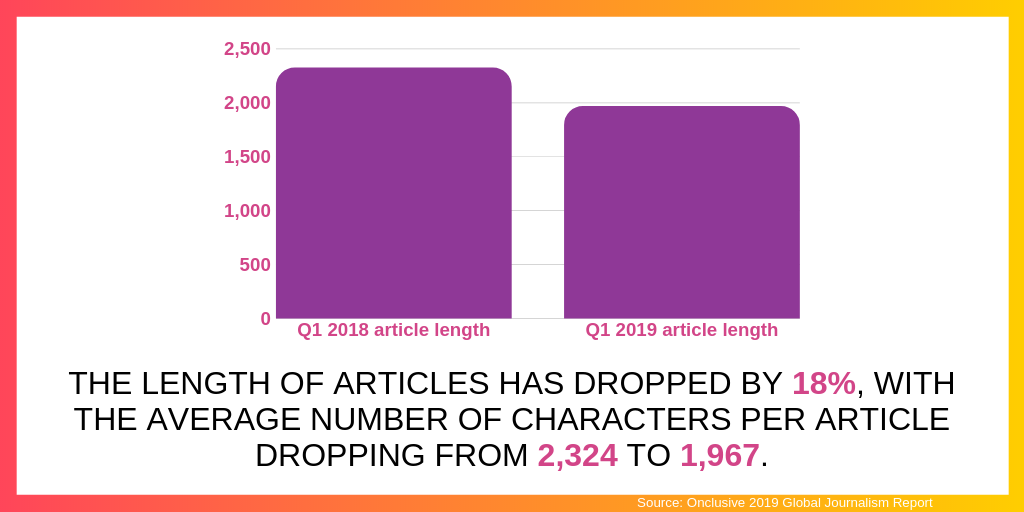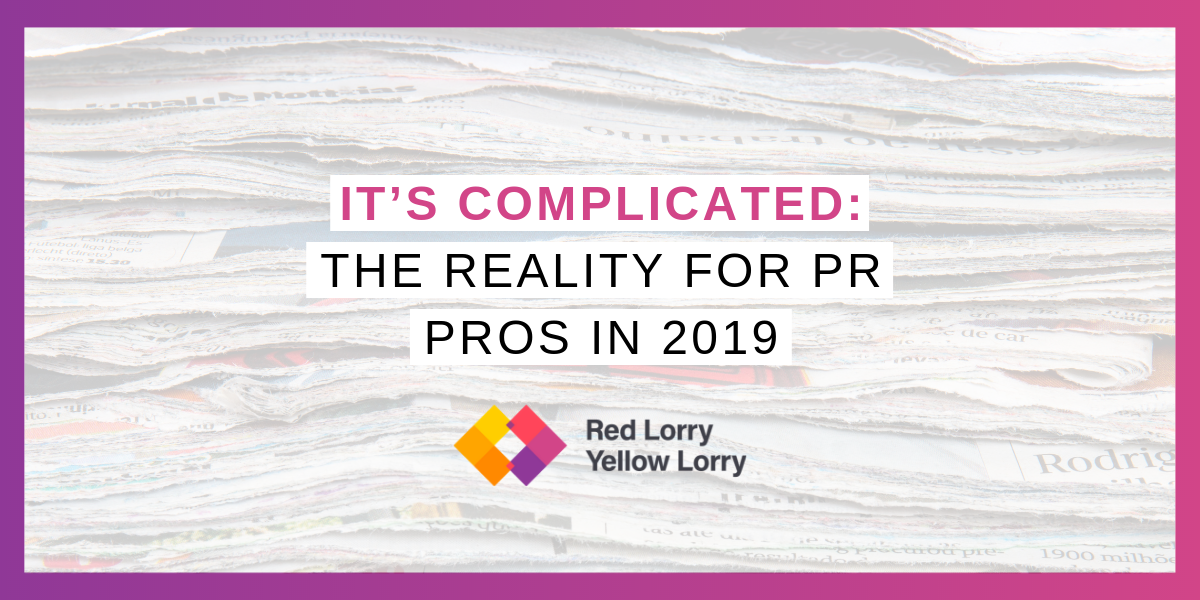Click here to sign up to our newsletter
PR and media relations has always been a complicated industry. PR pros have got to know the right people, balance multiple different types of relationships, adapt to the ever-changing needs of clients and keep tabs with changes in the industry – all while building their technical knowledge (if they work in tech PR).
And this certainly isn’t an industry that stands still. We’ve all known that PR has been getting more and more complicated for some time due to a combination of factors – and now we have the proof to back it up.
This rise in complexity is a key takeaway of the new Onclusive 2019 Global Journalism Report, which analysed 2.1 billion pieces of editorial content between Q1 2018 and Q1 2019. The report paints a picture of an industry that is fragmenting across publication tiers, editorial topics, and content formats – presenting some significant challenges for PR professionals.
PR and journalism landscape
Let’s start with where journalists are plying their trade. According to the report, the last 12 months has seen a drop in the percentage of authors contributing to tier 1 publications, decreasing from 26% in Q1 2018 to 15% in Q1 2019. The opposite is true for tier 3 publications – i.e. the more niche content sites and blogs – where the percentage of authors has risen from 25% to 41%.
This shift suggests that there are now fewer ‘professional journalists’ in the industry, with a greater number of independent authors. And, given that most clients want to see their names in the more established tier 1 publications, it presents some obvious PR challenges when it comes to breaking through to these top journalists and competing for their attention.
The traditional newsroom is also declining in size and scope, with the ratio of PRs to journalists at an all-time high – it is estimated that there are now six PR pros for every journalist. Simply put, there are fewer paid positions as reporters and news correspondents on offer, a trend which is expected to continue over the coming years.

Finally, content is becoming shorter and more “snackable” in nature. The overall length of articles has dropped by 18%, with the average number of characters per article dropping from 2,324 to 1,967.
While this may not sound like a issue, it matters from an SEO perspective (as our digital team will tell you). For example, there is a direct correlation between the length of an article and its likelihood to appear on the first page of Google’s search results, which is the ultimate destination for any piece of content. Generally, long-form articles are more likely to appear higher up the rankings, meaning shorter article lengths could have a long-term impact for publications and businesses alike.

It’s not all bad
The report does, however, offer some good news as well. For example, Business/Professional and Information Technology make up two of the top three most popular editorial topics – which fits into our sweet spot as a b2b tech agency. There is also greater diversity in editorial subjects being written about, which goes beyond the most obvious news topics and offers opportunities for PR pros to exploit.
The average number of articles published per author is also growing. This is likely to reflect the increasing demands being placed on journalists as publications continue to downsize their editorial teams, meaning writers are now having to cover multiple beats and deliver a higher output. This also illustrates how the ability to publish across a wider range of digital channels is resulting in more content being generated overall.
So what?
The big question is what does all this mean for PR pros? Well, with fewer journalists to interact with, agencies are having to be more targeted with their pitches. More time is having to be spent on identifying a specific selection of journalists that are likely to be interested and creating bespoke pitches that engage them on a more personal level. This is especially true for writers at tier 1 publications that have to be particularly selective about the stories they cover.
“While the media landscape has gotten a lot smaller and more competitive over the years, there’s a silver lining: the emphasis is back on relationship-building,” said Justin Ordman, account director at the lorries. “And like all relationships, these need a lot of TLC. They also need to be able to trust that we can deliver them fresh points of view and bold opinions that they can’t get elsewhere, which makes personalisation key.”
The methods of evaluating PR performance are also changing, with more of a focus on connecting content to tangible business outcomes. Today’s PR pros require real-time insights into the quality, engagement, influence and impact of content placements, all of which can help prove value in a fragmented media ecosystem.

Suggested Post
B2b data marketing as a trend – when will it end?
Using data is a vital part of b2b marketing, which has helped data marketing as a trend to blow up over the last couple of years – look...
Read MoreThis is where content marketing, for example, is playing a more prominent role. Rather than just churning out press releases, agencies are having to create different types of content – e.g. blogs, thought leadership articles, e-books, social posts etc. – and use them in lots of different ways. Whether the goal is to generate leads or drive awareness, an effective and efficient use of content is now key to cutting through the noise and being seen by the right people.
Ultimately, with any PR or marketing investment, clients want to know that they are getting their money’s worth. With the role of a PR pro becoming more complicated as the industry continues to fragment, being able to think outside the box and proof value outside of traditional media relations avenues will be essential in the years to come.
If you’d like to learn more about how we can help you engage the people you want to influence through our PR and content marketing services, visit our contact page or email us at hello@rlyl.com.
Click here to sign up to our newsletter



